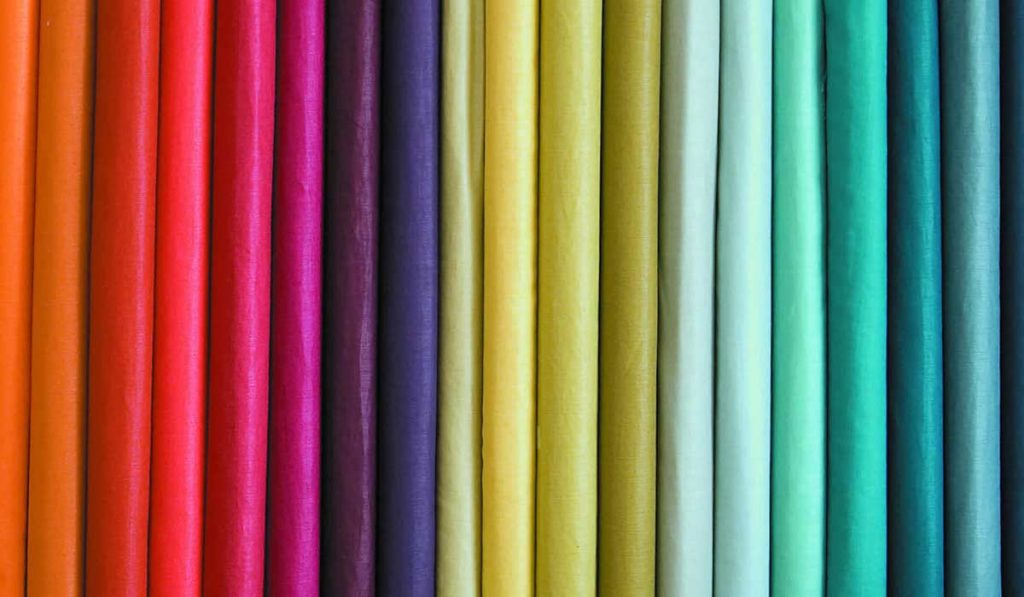Whenever you walk into an unfamiliar home, the first thing you’ll usually notice (unless the house is a complete pigsty) is the overall ambience. Warm or foreboding, cheerful or depressing – every living space has a definite feel to it.
What creates that feeling? Above all else, the colours featured in the home’s décor define its character. The layout and style of furnishings, the amount of open space, and even the textures of the window treatments and area rugs are all important factors, but colour plays the greatest role of all. Even something as simple as a tablecloth colour can go a long way toward creating the perfect look for a room.
The Psychology of Colour
Finding and using the right colours to create a look or mood isn’t a matter of guesswork. Ancient civilisations as diverse as the Chinese, Egyptians and Romans all considered the use of colour a science and carefully studied colours and their effect on human behaviour and perceptions. Some of history’s greatest philosophers and scientists, like Aristotle and Leonardo da Vinci, developed their own colour theories and systems. And renowned psychiatrist Carl Jung, the founder of analytical psychology, was a pioneer in the field of modern-day colour psychology and its implications for patient treatment.
Research into the effects of colour on the brain has continued since then. Just one example is a lengthy treatise in Scientific American, summarising many of the studies which have been done simply on the impact of the colour red. It’s a fruitful subject for exploration because light is the most important visual cue the brain receives and the colour of that light defines the way it is interpreted.
The psychology of colour isn’t only important to researchers and medical professionals. Today’s marketing theories rely heavily on the impact that colours have on advertising campaigns and product packaging. Many studies and data have been produced on every possible effect that colour can have on consumer decisions, and most marketing professionals study them avidly.
The same knowledge of the impact colours can have is utilised by many interior design specialists and firms; some even have their own “technical colour consultants” to ensure that the colours and shades used in a project will have the desired effect.
Naturally, you don’t have to rely on expensive design firms or “technical consultants” to choose the proper colours to use in your home. You can use the basic tenets of colour psychology to select the ideal furniture for your rooms and to pick the right shade of soft goods to accent and complete the look.
One of the most cost-effective ways to do that is by your choice of tablecloth colour. Here’s a look at what each common tablecloth colour says about you and the effect it will have on your room.
Blue Tablecloths
Positive meanings
Calm, cool, intelligent, professional, peaceful, stable, trustworthy, efficient, tranquil.
Negative meanings
Cold, unfriendly, aloof, conservative, deceitful, depressing, sad.
What is it used for
Research repeatedly shows that more people identify blue as their “favourite colour” than any other. As with most colours, though, there is a big difference between light, dark and vibrant shades. Darker blues are said to stimulate the brain and represent power, while lighter shades calm the brain while promoting tranquility and understanding. Studies have shown that blue is viewed much more positively among men than among women.
A light blue tablecloth can add colour and a relaxed feel to a warm room, yet in a room that already feels cold or sterile, it can contribute to the negative feelings already evoked by the décor. A darker shade of blue in an already-dark room, however, may increase feelings of sadness.
Blue is a colour that must be used carefully, but when the shade is properly chosen to work with the walls, floor and furnishings, you can create a room that looks either striking and professional or calming and welcoming. One important fact to know: studies have shown that the colour blue reduces appetite, so placing a blue tablecloth on a dining table may be a bad idea unless you’re running short on food.
View blue wipe clean tablecloths here.
Red Tablecloths
Positive meanings
Strong, courageous, powerful, energetic, joyful, loving, passionate, bold, warm, vibrant
Negative meanings
Anger, defiance, danger, malice, aggression
What it is used for
Most shades of red are striking, but that is simply because of the way the brain reacts to light. The wavelength of red light is the longest on the spectrum, so the brain perceives anything red as being closest to the body and sees the colour “first.” That’s why red is used to represent “stop” on traffic lights and signs.
As a powerful colour, red is a perfect accent to add bold or strong accents to a room but can easily be overdone, particularly because research has shown that bright reds increase the body’s rate of respiration (hence the “fight or flight” reflex often associated with red). A red tablecloth will add a vibrant, energetic or warm element to an otherwise-neutral room, but using one in an area already filled with red shades may trigger subconscious feelings of anger or make a room appear dangerous or forbidding.
View red wipe clean tablecloths here.
Green Tablecloths
Positive meanings
Safe, natural, fresh, balanced, reassuring, peaceful, restful, durable, reliable, luxurious, harmonious.
Negative meanings
Greedy, ambitious, jealous.
What it is used for
The proper use of the colour green in interior design can simulate a natural look and incorporate a feeling of serenity and safety. That’s believed to be linked (on a primitive level) to the fact that green spaces in nature have an abundance of water, making them a safe place to live. Improper use of the colour, however, can make a space look garish. In most cases, green will not blend well with contrasting colours like blue or red, so use it carefully.
When choosing a green tablecloth, shades like willow and olive green which have strong yellow components, will convey the feelings of harmony and peace most people associate with nature. Emerald green, on the other hand, will add elements of luxury and opulence to a room.
View green wipe clean tablecloths here.
Black Tablecloths
Positive meanings
Powerful, serious, mysterious, elegant, sophisticated, solid, glamorous, protective.
Negative meanings
Cold, evil, menacing, severe, death.
What it is used for
Many people shy away from using black in making their design or accent choices. They shouldn’t. If not overused, black plays well with every other colour, making bold ones look brighter and harmonising perfectly with most pastel shades. Black is also is a striking match with most shades of wood.
A black tablecloth is not the best choice for a dark room, because of the cold and menacing feelings the colour will contribute to the overall feel of the space. In a room dominated by white and neutral shades, though, it will add an element of elegance and a serious feel to the décor and can also be a perfect counterpoint to a space filled with bright colours or pastels.
View black wipe clean tablecloths here.
Cream Tablecloths
Positive meanings
Calm, pure, soft, clean, rich, human, quality.
Negative meanings
Docile, neutral, weak.
What it is used for
Cream is a very underused colour. Many who want a clean, modern look rely completely on whites without realising that cream will blend well with white to warm and humanise an otherwise stark room. The colour conveys a feeling of richness and quality, whether used in conjunction with neutral shades or more vibrant ones.
A cream tablecloth can be the perfect choice in a room in which whites and other neutral colours predominate in order to create a soft and welcoming environment. It will also soften the look of many wood tables and chairs for a rich and comforting look and can complete the overall appearance of a space heavy in blacks or heavy browns.
Grey Tablecloths
Positive meanings
Traditional, serious, subtle.
Negative meanings
Dull, boring, neutral, unsure, depressing, distant.
What it is used for
Grey is a very tricky colour to use in interior design because it can easily lend a dull feel to a room without contributing anything positive to a room’s appearance. The reason is simple: researchers have found no strong positive psychological feelings associated with the colour. Grey is associated more with hibernation than any positive activity, so it is a poor standalone choice in decorating.
However, a grey tablecloth can be used effectively to tone down a room featuring lots of bright, contrasting colours or to fit into a white-and-black décor featuring many different textures. The best grey tablecloth is often one that is also patterned or textured to minimise the negative vibrations and dull appearance given off by solid grey.
View grey wipe clean tablecloths here.
Yellow Tablecloths
Positive meanings
Joyful, happy, energetic, cheerful, friendly, optimistic, stimulating, creative, confident, lively
Negative meanings
Cowardly, overwhelming, anxious, irrational, anxiety, caution
What it is used for
A small amount of yellow can go a long way. The colour stimulates the brain, and you only have to step outside on a sunny day to understand the mood-elevating possibilities of being exposed to bright yellow light. However too much of the colour quickly becomes overwhelming and can induce discomfort, anxiety, or even fear.
A yellow tablecloth is an excellent vehicle for introducing some of the positive effects of the colour without overdoing things. It can be paired with varying shades of white to create a happy, joyful environment; used to balance vibrant complementary colours for an energetic feel; or mixed with whites, oranges and reds to build a calmer yet happy overall impression. Just remember that too much yellow quickly turns the mood from cheerful to anxious.
White Tablecloths
Positive meanings
Pure, innocent, safe, clean, peaceful, traditional, simple, efficient, sophisticated.
Negative meanings
Cold, sterile, unfriendly, elite.
What it is used for
White is the most common colour used in interior design and is traditionally used by decorators to embody most of the colour’s positive meanings, from clean and safe to simple and peaceful. It is essential to minimalist approaches because it creates a sophisticated atmosphere but is equally useful in more traditional settings.
A traditional white tablecloth may symbolise a setting that is perfect for fine dining, but the use of this colour can do much more. It creates an aura of safety and purity in a room – and of course, cleanliness if the tablecloth is on a dinner table. It will also add a level of elegance in a room with darker furnishings; however, beware of the cold and unfriendly appearance, which can be fostered when a white tablecloth is used in a room with primarily white and neutral shades.
Brown Tablecloths
Positive meanings
Casual, relaxing, natural, solid, reliable, enduring, serious, warm, earthy, supportive
Negative meanings
Heavy, unsophisticated, dirty
What it is used for
The natural and warm feelings evoked by the colour brown make it a natural and useful alternative to black in interior design. The earthy look of darker browns will make many rooms inviting, particularly when used in combination with greens to create a natural feel to the environment. And the tones of many browns, both dark and light, give a room the same solid feel that is usually the exclusive province of wood.
A brown tablecloth will have all of those advantages when placed into the proper environment, giving some rooms the relaxing aura of the outdoors, supplying others with a strong and reliable permanence.
Pink Tablecloths
Positive meanings
Romantic, friendly, sensitive, feminine, caring, nurturing, hopeful, tranquil, non-threatening.
Negative meanings
Weak, inhibited, immature, emotional, cautious.
What it is used for
This most feminine of colours wields a double-edged sword. The right amount can create a soft, caring and tranquil atmosphere, while too much pink takes all of those positive attributes and converts them into a weak, even childish, environment. Deep pink represents passion and sexuality, appropriate in some settings but definitely not in others.
A pink tablecloth displayed in a room with dark colours will contribute sophistication and sensitivity to the space, while one used in combination with reds and whites will add a friendly and softening influence to the décor. It can also be used as a calming element in a room that sees a lot of activity, as evidenced by the fact that studies prove pink surroundings can calm even violent and aggressive prisoners.
It might be hard to believe that a simple tablecloth colour could impact the ambience and feel of a room. But then again, the power of colour is the reason that major corporations employ marketing specialists with expertise in the field, and design firms have “technical colour consultants.” You’ll be surprised at the difference your choice of tablecloth colour might have.
The power of colour
It might be difficult to believe that a simple tablecloth colour could impact the ambience and feel of a room. But then again, the power of colour is the reason that major corporations employ marketing specialists with expertise in the field, and design firms have “technical colour consultants.” You’ll be surprised at the difference your choice of tablecloth colour might have.
References & sources
- https://blog.logodesignguru.com/brief-history-and-science-of-colors/
- https://en.wikipedia.org/wiki/Color_psychology
- https://www.scientificamerican.com/article/how-the-color-red-influences-our-behavior/
- https://en.wikipedia.org/wiki/Color
- https://www.psychologytoday.com/blog/habits-not-hacks/201408/color-psychology-how-colors-influence-the-mind





